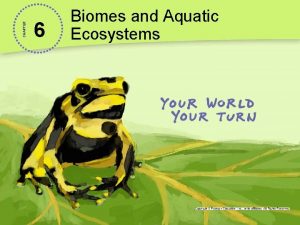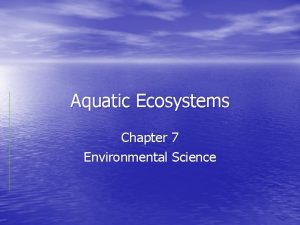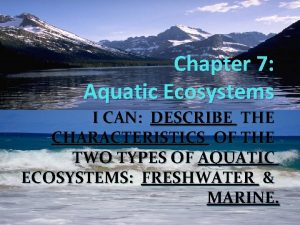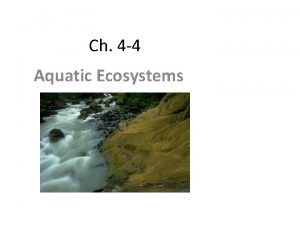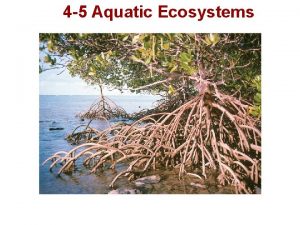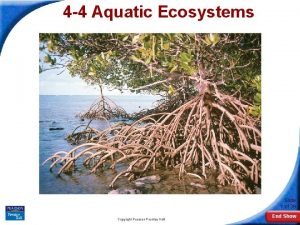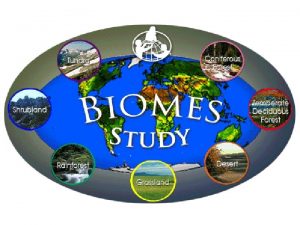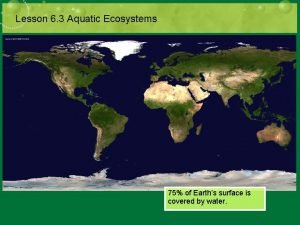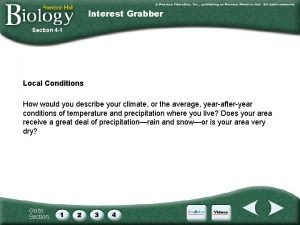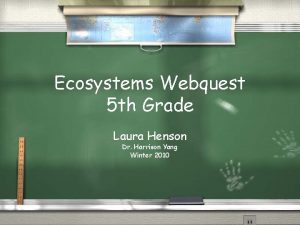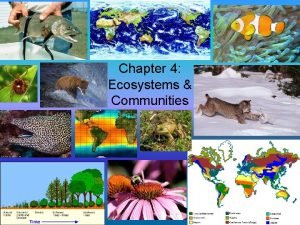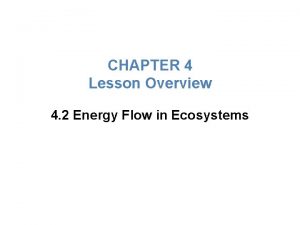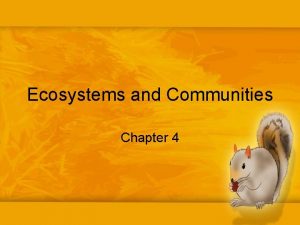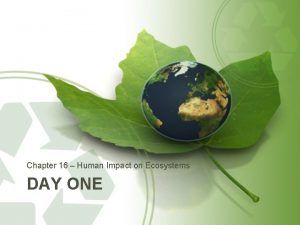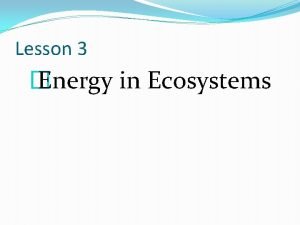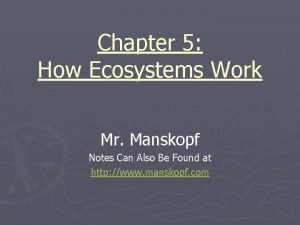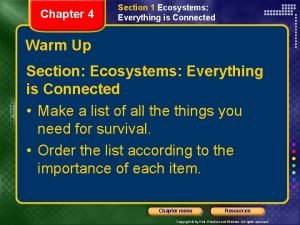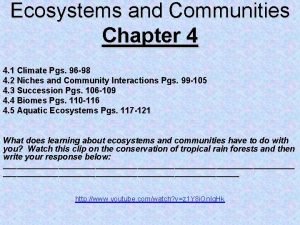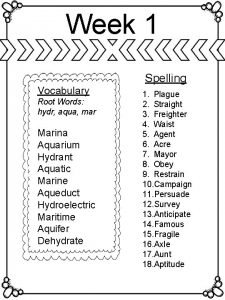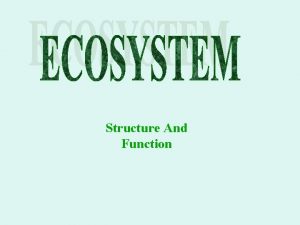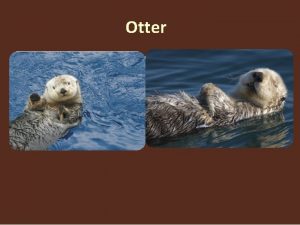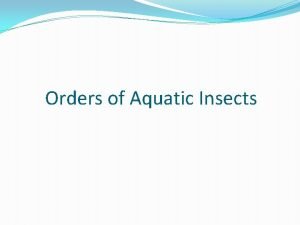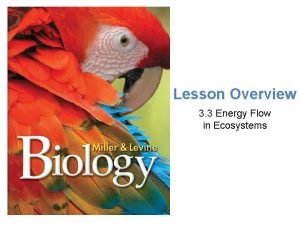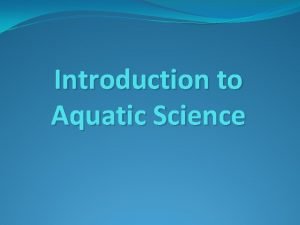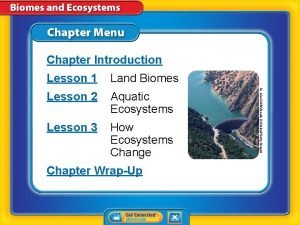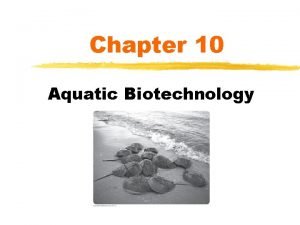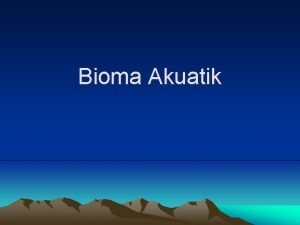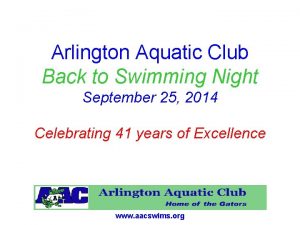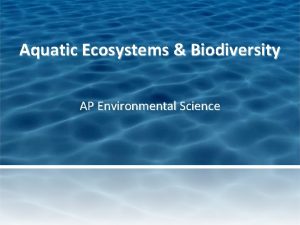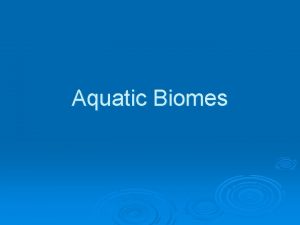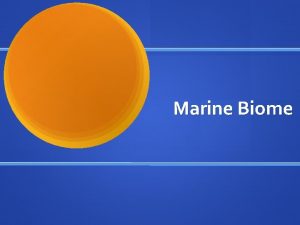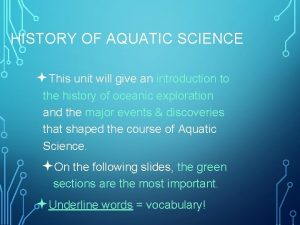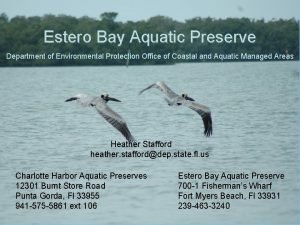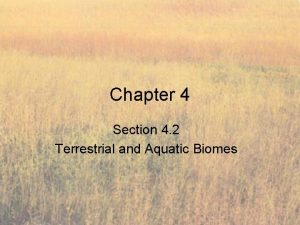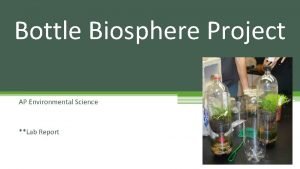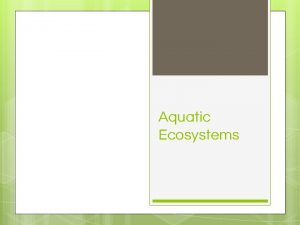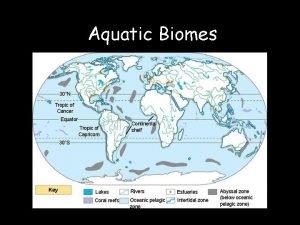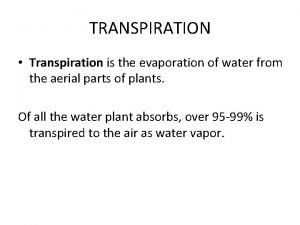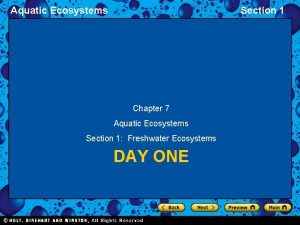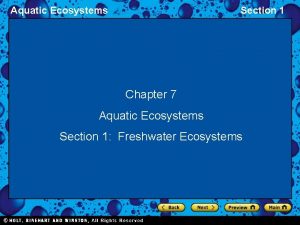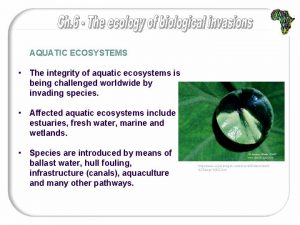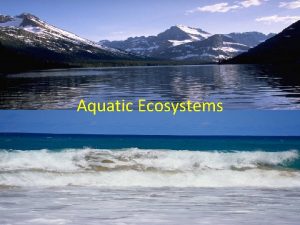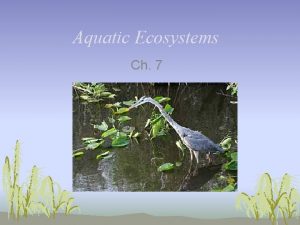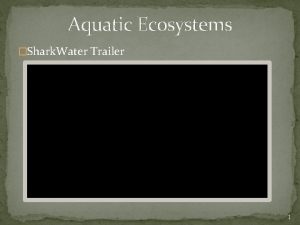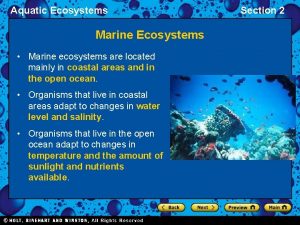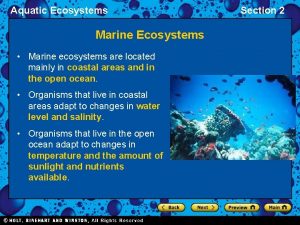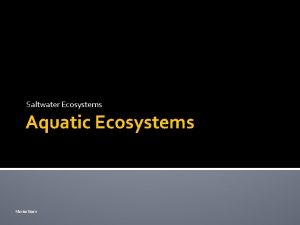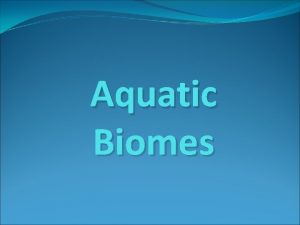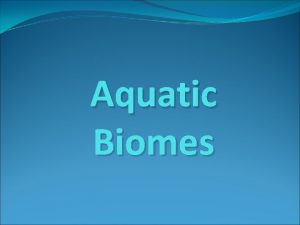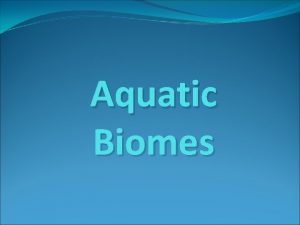Chapter 7 Aquatic Ecosystems Characteristics of Aquatic Ecosystems























































- Slides: 55

Chapter 7 Aquatic Ecosystems

Characteristics of Aquatic Ecosystems: • Type of organisms present is determined • • • by the salinity. Divided into two main types : freshwater and saltwater. Freshwater: lakes, ponds, rivers, streams and wetlands. Saltwater: coastal areas of marshes, swamps, and coral reefs as well as oceans and seas. There a few saltwater lakes.

Characteristics con’t. • Factors such as temperature, sunlight, oxygen, and nutrients determine which organisms live in which areas of the water. • Organisms that live in aquatic ecosystems are grouped by their location and by their adapatations.

Plankton – drifters; cannot swim • Phytoplankton: plant-like plankton • Base for most aquatic food chains. • Carry out the bulk of photosynthesis on Earth and provide most of the oxygen. • 70% of oxygen you breath can be traced back to phytoplankton • Examples: algae


Zooplankton: animal-like plankton

Nekton: free-swimming organisms

Benthos: bottom-dwelling organisms; may live attached to hard surfaces such as rocks

Ponds and Lakes Three Zones: 1. Littoral zone- shoreline Organisms include: Plankton, decomposers frogs, snails, dragonflies, water lilies, cattails, etc.

2. Limnetic Zone- open water zone that is sunlit Organisms include: a. plankton (1) phytoplankton- plant-like (2) zooplankton- animal-like b. nekton- organisms that actively swim. c. neuston- insects that live at the surface ex. whirligig beetle, water striders, insect larvae

3. Profundal Zone (Benthic zone) lake or pond bottom (no light) • Organisms are called benthos= bottom dwellers • crayfish, snails, clams, worms, and insect larvae and some fish such as catfish.


Life in a Lake • Animals that live in lakes and ponds have • • adaptations that help them obtain what they need to survive. For example, water beetles use the hairs under their bodies to trap surface air so that they can breathe during their dives for food. And, in regions where lakes partially freeze in the winter, amphibians burrow into the littoral mud to avoid freezing temperatures.

How Nutrients Affect Lakes • Eutrophication is an increase in the • amount of nutrients, such as nitrates, in an aquatic ecosystem. As plants and algae grow, the number of bacteria grow and oxygen is reduced so much that some organisms

How Nutrients Affect Lakes • A lake that has large amounts of plant • growth due to nutrients is known as a eutrophic lake. Lakes naturally become eutrophic over a long period of time, however, eutrophication can be accelerated by runoff, such as rain, that can carry sewage, fertilizers, or animal wastes from land into bodies of water.



Freshwater Wetlands • Freshwater wetlands areas of land that are covered with fresh water for part of the year. • 2 main types: 1) Marshes = contain nonwoody plants like reeds, catails, grasses etc. 2)swamps = woody plants. • Most freshwater wetlands are located in the southeastern United States, with the largest in the Florida Everglades.

Freshwater Wetlands

Importance of Wetlands • act as filters or sponges that absorb and • • remove pollutants from the water, control flooding by absorbing extra water when rivers overflow. home for native and migratory wildlife, in feeding and spawning grounds for many freshwater fish Recreation: fishing, birdwatching, hiking, canoeing

Marshes • The benthic zones of marshes are nutrient • • rich and contain plants, numerous types of decomposers, and scavengers. Water fowl, such as ducks, have flat beaks adapted for sifting through the water for fish and insects. While water birds, such as herons, have spearlike beaks they use to grasp small fish and probe for frogs in the mud. Marshes also attract migratory birds from temperate and tropical habitats.


Marsh Animals Blue Heron

Swamps • occur on flat, poorly drained land, often • • near streams and are dominated by woody shrubs or water loving trees. ideal habitat for amphibians because of the continuous moisture. Birds are also attracted to hollow trees near or over the water. Reptiles are the main predators of the swamp, eating almost any organism that crosses their path.


Human Impact on Wetlands • previously considered to be wastelands that • provide breeding grounds for insects so as a result, many have been drained, filled, and cleared for farms or residential and commercial development. The importance of wetlands is now recognized, so many are protected most states prohibit the destruction of wetlands. Wetlands serve as vital habitats for wildlife.

Rivers • At its headwaters, a river is usually cold • • and full of oxygen and runs swiftly through a shallow riverbed. As a river flows down a mountain, it may broaden, become warmer, wider, slower, and decrease in oxygen. A river changes with the land the climate through which it flows.

Life in a River • In and near the headwater, mosses anchor • themselves to rocks by using rootlike structures called rhizoids. Trout and minnows are adapted to the cold, oxygen rich water. Farther downstream, plankton can float in the warmer, calmer waters. Plants here can set roots in the river’s rich sediment, and the plant’s leaves vary in shape according to the strength of the river’s current. Fish such as catfish and carp also live in these calmer waters.

Animals in Rivers • Cold water, oxygen rich • Calm, warmer waters Catfish and Carp Trout and Minnows

Rivers in Danger • Industrial use of river water and people • using rivers as dumping grounds for sewage and garbage has polluted them with toxins which kill organisms and makes fish inedible Runoff puts pesticides and other poisons into rivers and coats riverbeds with toxic sediments.

Marine Ecosystems 7. 2

The ocean is divided into different zones. • Zones are determined by their distance from the shore line & water depths - intertidal zone - neritic zone - bathyal zone - abyssal zone intertidal zone neritic zone bathyal zone abyssal zone

A. Intertidal zone • Strip of land between high and low tide lines. • Organisms in this zone are alternately submerged and exposed. • Organism must contend with changes in temperature, amount of moisture, and salinity. ex. Sea anemone opens up at high tide and closes during low tide.

Animals of The Intertidal Zone Starfish and Crabs Sea anemones Mouth

B. Neritic Zone • Extends from the intertidal zone out to the edge of the continental shelf. • Depth can be from a few cm’s at low tide to more than 200 m’s deep. • Coral reefs and kelp forests occur here. • Contains 40 times more biomass than the rest of the ocean. • Most of the biomass consists of organisms called plankton.

Zooplankton- herbivores of the ocean


Animals of the Neritic Zone

C. Bathyal Zone • Extends from the edge of the neritic zone to the base of the continental shelf. • Between 200 and 2000 meters. • Water is turbid, or murky, due to the accumulation of silt. • Organism include fish adapted to living at high pressure and burrowing animals.


D. Abyssal Zone Lies below 2000 meters and is in complete darkness. • Chemosynthesis organisms are the base of food webs in the deep sea vents. •

Abyssal Organisms

Threats to the Ocean • Runoff from fertilized fields and industrial • • waste and sewage are major sources of ocean pollution. Overfishing and certain fishing methods are also destroying some fish populations. Marine mammals can get caught and drown in the nets. Although it is illegal, some ships discard fishing lines into the ocean where they can strangle and kill fish and seals.

Estuaries u An estuary is a partially enclosed body of water that forms where a river meets an ocean. – mixture of fresh water with salt water – Highly productive ecosystems – Ex. : Chesapeake Bay, Louisiana bayous

• Estuaries provide a protected refuge for many species. – birds migration – Fish spawning grounds, may be called “nurseries of the sea” – Important resource for commercial fisherman. 75% of the fish we eat depend on estuaries – provide a habitat for many endangered and threatened species. ex. brown pelicans, Morro Bay kangaroo rat

Threats to Estuaries • primarily threatened by land development • used as places to dump waste and then • • used building sites. Pollutants = sewage, pesticides, fertilizers, and toxic chemicals. Most pollutants break down over time, but estuaries cannot cope with the large amounts produced by dense human populations.

Salt Marshes • characterized by grasses, sedges, etc. • clams, fish, aquatic birds, crabs, and shrimp. • absorb pollutants to help protect inland areas.

Mangrove Swamps • tropical or subtropical marine swamps that are characterized by the abundance mangrove trees. • protect the coastline from erosion and reduce the damage from storms; provide a home for about 2, 000 animal species. • Many have been filled with waste and destroyed in many parts of the world.


Coral Reefs • limestone ridges found in tropical climates • • and composed of coral fragments that are deposited around organic remains. Thousands of species of plants and animals live in the cracks and crevices of coral reefs, which makes coral reefs among the most diverse ecosystems on Earth. Corals are predators that use stinging tentacles to capture small animals, such as zooplankton, that float or swim close to the reef.

Coral Reefs • Corals live only in clear, warm salt water with abundant light



Disappearing Coral Reefs • If the water surrounding a reef is too hot • or too cold, or if fresh water drains into the water surrounding the coral, the coral may die. If the water is too muddy, polluted, or too high in nutrients, the algae that live within the corals will either die or grow out control. If the algae grows out of control, it may kill the corals.

• Oil spills, sewage, pesticides, and silt runoff have also been linked to coralreef destruction. • Overfishing • destroyed by careless divers, ships dropping anchor, fisheries, shipwrecks, and people breaking off pieces for decorative items or building materials.
 Section 3 aquatic ecosystems worksheet answers
Section 3 aquatic ecosystems worksheet answers Chaparral biomes are generally _______.
Chaparral biomes are generally _______. Why biomes are important
Why biomes are important Chapter 3 lesson 3 biomes and aquatic ecosystems
Chapter 3 lesson 3 biomes and aquatic ecosystems Chapter 7 aquatic ecosystems
Chapter 7 aquatic ecosystems Chapter 7 aquatic ecosystems test answers
Chapter 7 aquatic ecosystems test answers Lesson outline lesson 2 aquatic ecosystems answer key
Lesson outline lesson 2 aquatic ecosystems answer key What are the two main types of aquatic ecosystems
What are the two main types of aquatic ecosystems Section 4-4 aquatic ecosystems
Section 4-4 aquatic ecosystems Differences between aquatic and terrestrial ecosystems
Differences between aquatic and terrestrial ecosystems What factors describe aquatic ecosystems
What factors describe aquatic ecosystems 4-4 aquatic ecosystems
4-4 aquatic ecosystems Section 4-4 aquatic ecosystems answer key
Section 4-4 aquatic ecosystems answer key Biomes and aquatic ecosystems
Biomes and aquatic ecosystems Lesson 3: aquatic ecosystems
Lesson 3: aquatic ecosystems Section 4-4 aquatic ecosystems
Section 4-4 aquatic ecosystems Ecosystem webquest 5th grade
Ecosystem webquest 5th grade Section 4-4 aquatic ecosystems
Section 4-4 aquatic ecosystems Chapter 4 lesson 2 energy flow in ecosystems
Chapter 4 lesson 2 energy flow in ecosystems Ecosystems and communities chapter 4 answer key
Ecosystems and communities chapter 4 answer key Phosphorus cycle pearson education
Phosphorus cycle pearson education Chapter 42 ecosystems and energy
Chapter 42 ecosystems and energy Chapter 16: human impact on ecosystems answer key
Chapter 16: human impact on ecosystems answer key Energy in ecosystems lesson 3 answer key
Energy in ecosystems lesson 3 answer key Chapter 5 how ecosystems work study guide
Chapter 5 how ecosystems work study guide Chapter 16 human impact on ecosystems
Chapter 16 human impact on ecosystems Chapter 55 ecosystems and restoration ecology
Chapter 55 ecosystems and restoration ecology Section ecosystems everything is connected
Section ecosystems everything is connected Chapter 14 interactions in ecosystems
Chapter 14 interactions in ecosystems Chapter 4 ecosystems and communities
Chapter 4 ecosystems and communities Aquarium root word
Aquarium root word Structure of ecosystem ppt
Structure of ecosystem ppt Are otters semi aquatic
Are otters semi aquatic Classification of aquatic insects
Classification of aquatic insects Energy flow
Energy flow What is aquatic science
What is aquatic science Pyramid of biomass in aquatic ecosystem
Pyramid of biomass in aquatic ecosystem Bird
Bird Connecting the concepts aquatic biomes
Connecting the concepts aquatic biomes Aquatic biotechnology
Aquatic biotechnology Akuatik adalah
Akuatik adalah Sport fair arlington
Sport fair arlington Ap environmental science biodiversity
Ap environmental science biodiversity Examples of aquatic biomes
Examples of aquatic biomes Model aquatic health code
Model aquatic health code Terrestrial food production systems
Terrestrial food production systems Hydrophyte adaptations
Hydrophyte adaptations Aquatic biomes examples
Aquatic biomes examples History of aquatic science
History of aquatic science Estero bay aquatic preserve
Estero bay aquatic preserve Aquatic biomes in canada
Aquatic biomes in canada Bottle biosphere
Bottle biosphere The uppermost layer of an aquatic ecosystem
The uppermost layer of an aquatic ecosystem The main limiting factors in an aquatic biome are
The main limiting factors in an aquatic biome are Code.org minecraft aquatic
Code.org minecraft aquatic Only water vapor evaporates through stomata.
Only water vapor evaporates through stomata.


